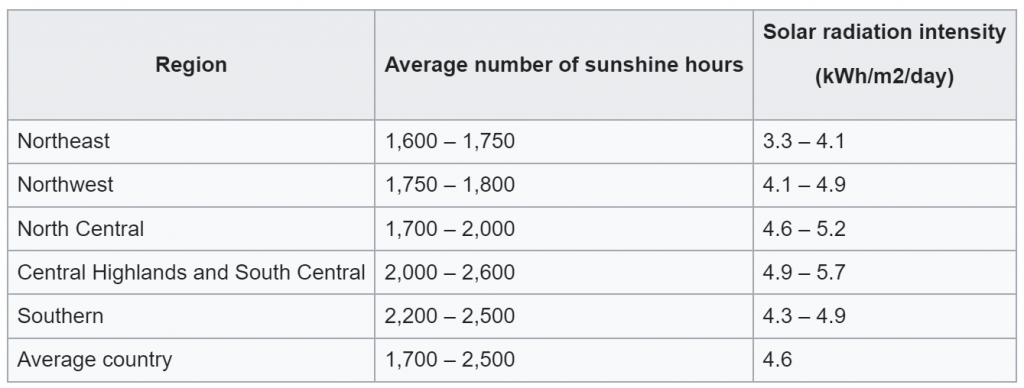Introduction
Vietnam, a dynamic and rapidly developing nation, is at a pivotal juncture in its journey towards sustainable energy. The realm of renewable energy in Vietnam is full of opportunity and transformation, reflecting the nation’s commitment to a greener future.
In this article, we delve into the intricate details of Vietnam’s renewable energy sector, exploring the current market trends, the immense potential of various renewable sources, and the notable projects that are shaping the energy landscape of this Southeast Asian powerhouse. From the bustling streets of Hanoi to the serene landscapes of the Mekong Delta, Vietnam’s energy sector is buzzing with innovation and growth.
Current Market Trends
Regarding the current market trends in Vietnam’s renewable energy sector, several key developments and factors are shaping the landscape:
Economic Growth and Rising Energy Demand:
- Vietnam’s rapid economic development is leading to an increased demand for energy. The expected annual growth in power consumption ranges from 10% to 12% until 2030.
- This growth is driven by industrialization and modernization, necessitating a reliable and sustainable energy supply. The growing demand is a key driver for the expansion of the renewable energy sector.
Shift Away from Fossil Fuels:
- Vietnam is moving away from coal, which has traditionally been a major source of its power generation, accounting for 34% of its power production.
- The shift is part of a broader trend to diversify the energy mix with more renewable energy sources. This is in line with global trends and Vietnam’s commitments to reducing carbon emissions and ensuring a sustainable energy future.
Investment in Renewable Energy:
- The renewable energy sector in Vietnam has become a hotbed for investments. Both local and international investors are showing a keen interest, buoyed by the government’s supportive policies and incentives.
- The sector’s growth is seen as a vital component of Vietnam’s strategy for economic growth and energy security. As a leader in renewable energy in Southeast Asia, Vietnam has capitalized on its potential to attract significant investment.
Solar Power Development:
- Vietnam has shown remarkable growth in its solar power sector. The country is leading in solar power development in the ASEAN region with a total technical potential for solar power of up to 1,646GW.
- The sector’s expansion has been bolstered by government policies like Feed-in Tariffs, which have incentivized rapid growth in solar installations across the country.
Grid and Infrastructure Challenges:
- The rapid expansion of renewable energy, especially solar, has put a strain on the existing power grid, which was primarily designed for conventional energy sources.
- These challenges include grid capacity limitations and the need for significant investment in grid infrastructure to integrate renewable energy effectively. The central region, where most renewable energy projects are located, has faced particular challenges.
Policy Initiatives and Feed-in Tariffs (FITs):
- High FITs have been instrumental in driving the rapid growth of renewable energy projects. However, they have also led to challenges such as grid capacity issues and financial strains on the state and end-users.
- The government has been adjusting policies, such as FIT rates and project approvals, to manage the sector’s growth and address these issues. This includes measures to ensure the financial sustainability of projects and the grid system.
Renewable Energy as a Key to Energy Security:
- The Vietnamese government sees renewable energy not just as an environmental initiative but as a crucial component of its energy security strategy.
- With the predicted increase in energy demand due to ongoing industrialization, renewable energy is essential to meet this demand sustainably. The government aims to increase the share of renewable energy in its energy mix to ensure a reliable and stable supply of energy in the future.
Renewable Energy Potential
While solar and wind are currently the primary focus of Vietnam’s renewable energy expansion, these other sources offer additional avenues for diversifying the energy mix and enhancing energy security. The development of these resources will depend on technological advancements, economic viability, and government policies aimed at supporting a broader range of renewable energy sources.
Wind Power in Vietnam
Vietnam’s geographical features, including a long coastline of 3,000 km and consistent winds, make it an ideal location for wind power development. The country has set ambitious targets for wind energy as part of its Power Development Plan 8 (PDP8), aiming to raise the contribution of solar and wind to 50% of the power supply by 2045.
Specifically, Vietnam plans to achieve 18 GW of wind energy by 2030 and an estimated 42.7 GW of onshore wind and 54 GW of offshore wind by 2045. The World Bank estimates that Vietnam’s offshore wind potential exceeds 500 GW, which could provide a significant base load that is currently supplied by coal. However, realizing this potential will require substantial investment, as Vietnam’s current wind power capacity is just under 4 GW.
Solar Power in Vietnam
Solar power also plays a significant role in Vietnam’s energy mix, with the potential to provide up to 963,000 MW of electricity. This includes ground-based, floating, and rooftop solar installations. The PDP8 outlines plans to increase the capacity of solar power by 4,100 MW and rooftop solar power production by 2,600 MW by 2030. Vietnam has successfully tapped into local private investment for solar energy, scaling up its capacity to more than 16,000 MW in 2022, far surpassing government targets.

Biogas Energy
Vietnam’s biogas sector primarily focuses on leveraging agricultural waste and livestock by-products, especially from the pig farming industry. The country has a significant number of large and medium-sized pig farms, over 8,500, which are already using biogas digesters for manure treatment. This sector holds substantial potential for generating electricity through biogas-to-electricity solutions, which could also contribute to reducing greenhouse gas emissions.
Programs like the Bio-energy for Circular Agriculture (BeCA) and the Vietnam Biogas Programme are actively working to scale up sustainable electricity generation in this sector. These initiatives aim to provide a cheaper, secure, and sustainable energy source for farms and reduce energy costs by 20-30% while contributing to environmental sustainability. The success of these programs also involves collaboration with local and international organizations, including the Australian Government and various Vietnamese entities, to promote the use of biogas and enhance its viability and awareness.
Geothermal Energy
Vietnam’s geothermal energy potential is still in its nascent stages, and detailed information about its current status and prospects is limited. Geothermal resources could offer a sustainable and stable source of heat and power, but exploration and development in this area are yet to be significantly pursued or realized.
Tidal and Wave Energy
Similarly, the potential for tidal and wave energy in Vietnam is an area that has not been extensively explored or developed. The country’s long coastline suggests a possibility for harnessing these renewable energy sources. However, the current focus and investment in renewable energy in Vietnam are predominantly oriented towards wind and solar power.
Notable Renewable Energy Projects In Vietnam
Wind Power
Offshore wind capacity accounted for 0.7% of total power plant installations globally in 2021, according to GlobalData, with total recorded offshore wind capacity of 54GW. This is expected to contribute 2.1% by the end of 2030 with capacity of installations aggregating up to 263GW. Of the total global offshore wind capacity, 1.40% is in Vietnam. Below are examples of offshore wind power plants in Vietnam.
- Tra Vinh Dong Hai 1 Wind Farm: This is a 100MW offshore wind power project located in the East Vietnam Sea. It was commissioned in 2021 and developed by Trungnam Tra Vinh 1 Wind Power, owned by Trungnam Group. This project is a significant step in enhancing Vietnam’s wind energy capacity.
- Bac Lieu Wind Farm: Another key project is the Bac Lieu Wind Farm, located in the South China Sea, Vietnam. It has a capacity of 99.20MW and was commissioned in 2013. This project was developed and is owned by Cong Ly Construction-Trade-Tourism.
- Hiep Thanh Wind Power Project: Hiep Thanh Wind Power Project with a capacity of 78 MW and an annual average generation of 300 Gwh, including 18 wind turbines is developed on a total area of 2,747 ha, in the coastal alluvial land, Hiep Thanh commune, Duyen Hai town (Tra Vinh province).
Solar Power
Vietnam has undertaken several notable solar power projects, demonstrating its commitment to sustainable development and energy security. Some of these projects include:
- Dau Tieng Solar Power Complex: This project is Southeast Asia’s largest solar project and has attracted significant foreign direct investment and private investment. Dau Tieng Project composes 3 projects which are Dau Tieng 1, Dau Tieng 2 and Dau Tieng 3 with a total generating capacity of 600 MWp / 500 MWac.
- Phong Dien Solar Power Plan: TTC Phong Dien Solar Power Plant operates and generates about 60 million kWh/year. This nearly equals to the yearly electricity consumption of 32.628 households in Vietnam. As estimated, the amount of CO2 emission reduces about 20.503 ton/year.
- Trung Nam Solar PV Park: The Trung Nam Solar PV Park has been operating since 2019. The 258MW solar PV project is located in Ninh Thuan, Vietnam. It generates between 401 million and 450 million kWh of electricity annually. Its output is sold under a power purchase agreement (PPA) with Electricity of Vietnam’s (EVN) Electric Power Trading Company (EPTC).
Conclusion
Vietnam’s renewable energy sector stands as a highlight of progress and potential in Southeast Asia. The country is leveraging its natural resources and strategic policies to revolutionize its energy landscape. From the sprawling solar farms in Ninh Thuan to the towering wind turbines off its coastlines, Vietnam is not only meeting its growing energy needs but is also setting a precedent for sustainable development.
These endeavors in harnessing wind, solar, biogas, and exploring untapped resources like geothermal and tidal energy, demonstrate Vietnam’s commitment to reducing its carbon footprint and ensuring energy security. The journey is undoubtedly filled with challenges, from infrastructure development to policy fine-tuning, yet the strides made thus far herald a promising future. As Vietnam continues to navigate the complexities of renewable energy development, it stands as an example of the power of innovation, resilience, and foresight in building a sustainable world.
References
- McKinsey & Company. (2023) ‘Vietnam’s potential for renewables’, McKinsey & Company. Available at: https://www.mckinsey.com/featured-insights/sustainable-inclusive-growth/chart-of-the-day/vietnams-potential-for-renewables
- United Nations Development Programme. ‘Vietnam takes full turn to renewables by 2050’, United Nations Development Programme. Available at: https://www.undp.org/vietnam/blog/vietnam-takes-full-turn-renewables-2050
- International Union for Conservation of Nature. (2022) ‘Opportunities and challenges in expanding wind in Vietnam’s electricity mix’, International Union for Conservation of Nature. Available at: https://www.iucn.org/news/viet-nam/202205/opportunities-and-challenges-expanding-wind-vietnams-electricity-mix
- VnExpress International. (2021) ‘Vietnam targets 75 pct energy from renewables by 2045’, VnExpress International. Available at: https://e.vnexpress.net/news/business/industries/vietnam-targets-75-pct-energy-from-renewables-by-2045-4396933.html
- The Diplomat. ‘The Reality of Vietnam’s Energy Transition’, The Diplomat. Available at: https://thediplomat.com/2022/11/the-reality-of-vietnams-energy-transition/#:~:text=An%20%E2%80%9Cenergy%20transition%E2%80%9D%20can%20be,be%20successful%20in%20Vietnam’s%20case.
- SNV. ‘Scaling Bioenergy on commercial farms in Vietnam’, SNV. Available at: https://www.snv.org/project/scaling-bioenergy-commercial-farms-vietnam-beca
- SNV. ‘Vietnam Biogas Programme’, SNV. Available at: https://www.snv.org/project/vietnam-biogas-programme
- Event Always. (2024) ‘Biogas & Biomass Energy Asia Summit 2024 Vietnam Focus’, Event Always. Available at: https://www.eco-business.com/events/biogas-biomass-energy-asia-summit-2024-vietnam-focus/
- SNV. ‘Scaling bioenergy on commercial farms in Vietnam (BeCA)’, SNV. Available at: https://www.snv.org/project/scaling-bioenergy-commercial-farms-vietnam-beca
- Reuters.’Vietnam approves plan to boost wind, LNG by 2030′, Reuters. Available at: https://www.reuters.com/business/energy/vietnams-pm-approves-135-billion-power-plan-2030-2023-05-15/
- Energy Tracker Asia. ‘Wind Energy in Vietnam – Opportunities and Potential’, Energy Tracker Asia. Available at: https://energytracker.asia/wind-energy-in-vietnam-opportunities-and-potential/#:~:text=While%20ahead%20of%20many%20other,of%20up%20to%20600%20GW.&text=In%20the%20past%2C%20it%20has,its%20vast%20clean%20energy%20resources.
- Vietnam Briefing. ‘How Can Investors Seize Vietnam’s Wind Power Potential’, Vietnam Briefing. Available at: https://www.vietnam-briefing.com/news/how-can-investors-seize-vietnams-wind-power-potential.html/
- Electric & Power Vietnam. ‘Vietnam has the potential to localize renewable energy technology’, Electric & Power Vietnam. Available at: https://electricvietnam.com/2023/12/21/vietnam-has-the-potential-to-localize-renewable-energy-technology/?lang=en
- Vietnam Briefing. ‘Vietnam’s Power Development Plan 8: What You Should Know’, Vietnam Briefing. Available at: https://www.vietnam-briefing.com/news/vietnam-power-development-plan-approved.html/
- Tạp chí Năng lượng Việt Nam. ‘Current Status of Offshore Wind Power and Development Direction in Vietnam’, Tạp chí Năng lượng Việt Nam. Available at: https://vietnamenergy.vn/current-status-of-offshore-wind-power-and-development-direction-in-vietnam-31478.html
- Vietnam+. ‘Roadmap recommended for offshore wind power development’, Vietnam+. Available at: https://en.vietnamplus.vn/roadmap-recommended-for-offshore-wind-power-development/187436.vnp
- Eco-Business. ‘Renewables are booming in Vietnam. Will the upswing last?’, Eco-Business. Available at: https://www.eco-business.com/news/renewables-are-booming-in-vietnam-will-the-upswing-last/.
- Vietnam Briefing. ‘Renewables in Vietnam: Current Opportunities and Future Outlook’, Vietnam. https://www.vietnam-briefing.com/news/vietnams-push-for-renewable-energy.html/







